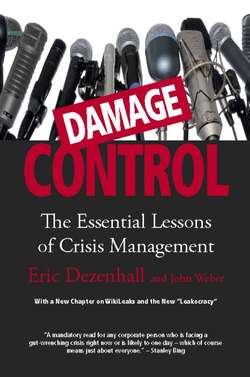Читать книгу Damage Control (Revised & Updated) - Eric Dezenhall - Страница 12
На сайте Литреса книга снята с продажи.
A QUESTION OF PROVENANCE
ОглавлениеThe tampering almost surely was the work of a psychopathic killer external to J&J. That the origin of the wicked act was not J&J was the key variable setting the foundation for its recovery. A company attacked by a criminal will be forgiven far more quickly than one accused of being the criminal. J&J’s actions were admirable but logical. People were killed, so the company pulled the product from stores and encouraged consumers to throw it away.
The Tylenol case falls into a category we call a sniper-fire crisis—one that is caused by an outside force, like a deranged killer. Nobody’s rooting for the sniper. Consumers intuitively understand that the executives of J&J didn’t convene in an underground bunker to hatch a plan to harm consumers. The public might be willing to believe that a company is capable of negligence or penny-pinching irresponsibility, but in J&J’s case the crimes were simply too horrific for rational people to believe that a corporation that had staked its reputation on consumer goodwill for almost a century would want something like this to happen.
As with any compelling story, the public demands instant archetypes, especially villains and victims. People process their intuition using a very specific template, one that factors in the cornerstone of Western legal and social ethics: intent. In the Tylenol case, J&J was, in addition to those who lost their lives, immediately—and instinctively—perceived as a victim, not the perpetrator of the crime.
The corporate scandals that dominate today’s news are mostly of a different strain: The company’s very character is on trial—for making faulty products or betraying the public trust. The company is the villain in this scenario. While it was inconceivable that J&J would knowingly harm its consumers, the recent spate of product liability and financial malfeasance scandals are all intuitively plausible.
Ford and Firestone were accused of knowingly manufacturing dangerous trucks and tires. Merck and Pfizer had to answer hard questions about the potentially deadly side effects as well as the efficacy of their arthritis drugs Vioxx and Celebrex, respectively. WorldCom, Tyco, Arthur Andersen, Enron, HealthSouth, and Adelphia instantly became cultural emblems of corruption as prosecutors accused company leaders of scheming to enrich themselves at the expense of others.
Character-driven crises like these—the opposite of a sniper-fire crisis—do not lend themselves to textbook solutions because they affect the economy, culture, and political landscape rather than just a discrete, if unfortunate, segment of the population. Evaporated pension funds make Americans’ wrath toward scandal figures so virulent that public relations rescues are not options. The public doesn’t just want answers; it wants vengeance. The facts of character-driven cases are not as relevant as what the cases come to symbolize in the public psyche.
Accounting giant Arthur Andersen took admirable steps to prevent extinction, such as forming a blue-ribbon panel with even bluer-chip names to examine what went wrong, but principals still were convicted (later overturned) of obstructing justice, and the firm went bankrupt. In 1989, Perrier, at the time the leading importer of bottled water in the U.S. market, adopted the Tylenol-inspired model of the instant recall when the chemical benzene was found in its product. It was commonly believed that benzene was a by-product of the manufacturing process or occurred naturally at the source from which Perrier water was derived. Regardless, the brand never fully recovered, and is not even among the top bottled waters in the United States today.
